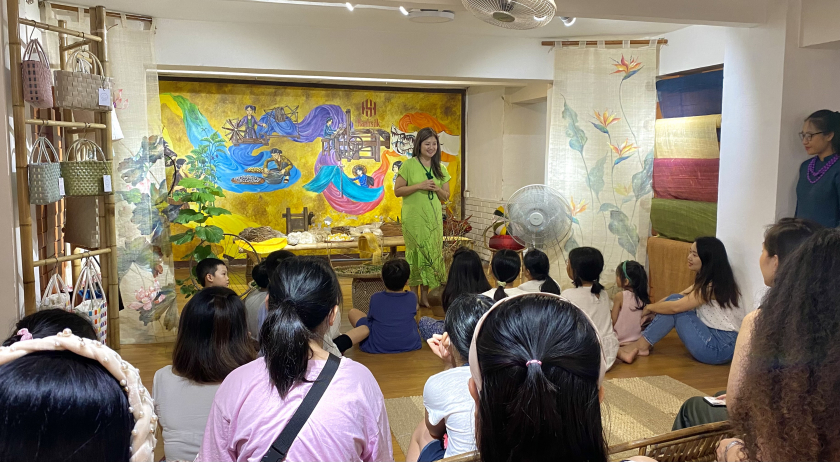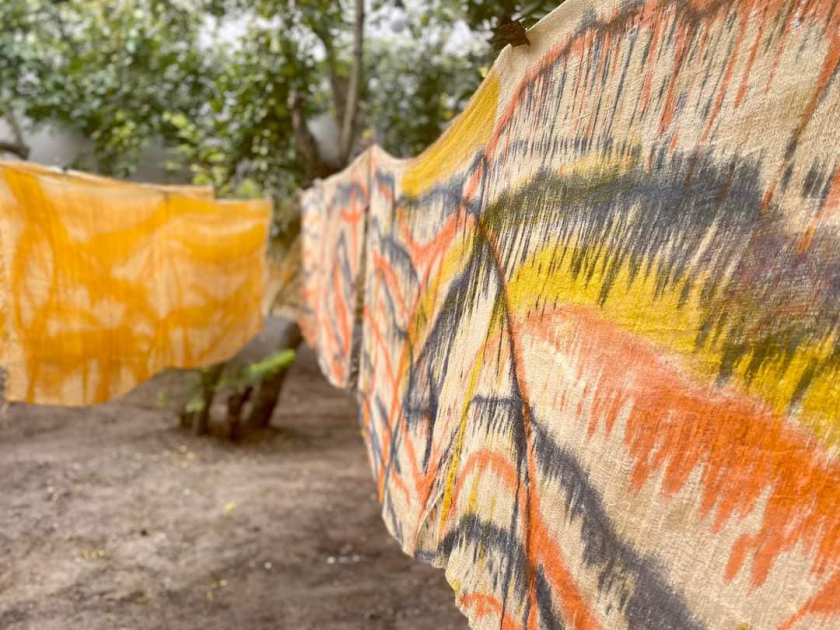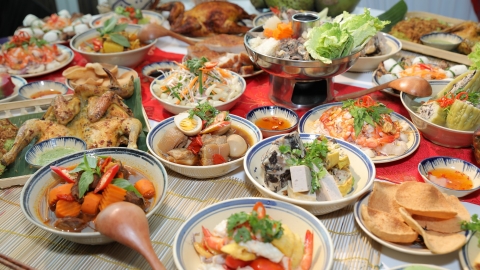On a sunny Sunday afternoon, the golden sunshine covered the streets of Hanoi. I came to a house with ancient architecture located modestly in the Van Ho Exhibition Center. Not far from the busiest area of the capital, this place has a classical, gentle beauty, vaguely reminiscent of a peaceful Vietnamese village. There is a pretty conical hat hanging on a cool green bamboo clump, there are tall shady trees letting in tiny rays of sunlight falling right in front of the porch, all inviting and leading me into a magical world of traditional colors.
That day, I attended Hanhsilk's "Learning about Nam Cao Silk" Workshop with excitement and a bit of curiosity about the silkworm breeding and weaving profession.

The sultry summer afternoon adds to the ancient atmosphere.
Growing mulberry, raising silkworms, weaving cloth
In a spacious yet cozy and intimate space, I listened to the story about the process of creating silk and linen products at Nam Cao Cooperative, Thai Binh province - one of the capitals of the textile weaving profession. Before that, my understanding of this long-standing traditional craft stopped at feeding silkworms with mulberry leaves, harvesting cocoons, taking silk and weaving it into fabric, but that was just a brief summary of an extremely complicated process.
For the silkworms to grow best, when the day of spinning is near, farmers must wake up at 4am to pick mulberry leaves as big as a hand to bring home as food for the silkworms. The process is repeated at 3pm to ensure the leaves are sufficient and freshest, providing nutrition for the hard-working silkworms. After five life cycles with four molts, the silkworms begin to spin silk to create cocoons. The cocoons are woven from the outside in until they take shape, which is also when the silkworms complete their task and transform into pupae. Before the pupae grow into caterpillars and break out of their cocoons, farmers must cut the cocoons to begin the silk reeling process.

Silkworms eat mulberry leaves to prepare to spin silk.
Perhaps, when mentioning silk, many people will imagine a soft, smooth, silky material, but in reality, the same silk thread can produce products with extremely different surfaces, from soft and light like satin silk to rough and rustic like linen... This is mainly determined by the silk reeling technique. If silk reeled by machine produces high yield and large, even, thin and smooth threads, then hand reeling in a pot of water produces larger threads, slightly rough but still soft and shiny. The most labor-intensive and skilled form of linen reeling is probably the form of reeling. People have to soak the cocoons in a pot of cold water for 3-5 hours until the cocoons are soft and then diligently pull the threads by hand. On average, each person can only reel from 0.7 to 100g of linen thread per day, much lower than the form of reeling by hand and using a machine. Although it is coarse, not as shiny and smooth as silk, linen fiber still has great appeal because of its natural, rustic and airy properties.

Silk products require a lot of effort to achieve the highest quality.
The silk threads are then twisted together to adjust the thickness, woven to create many types of fabric with various thinness, softness, drape, shine... The newly woven fabric has a natural color, slightly ivory. Depending on the needs, people will keep the original color of the fabric or dye it from natural materials such as leaves, fruits and vegetables to create eye-catching bright colors.
Listening to the traditional weaving story, directly watching the silkworms diligently eating leaves and spinning silk, and touching the soft silk products in a warm space makes everyone feel more appreciative of the traditional cultural beauty of the nation. With all the love and dedication of the artisans for the traditional craft, the silk fabrics are born. Not simply a product, it is also the crystallization of the Vietnamese soul, carrying in it diligence, honesty, simplicity and innocence.
Reviving the appeal of traditional crafts
Nowadays, with the explosion of technology and digital technology, young people are surrounded by pleasures and countless new imported products, traditional handicrafts are somewhat overshadowed.
However, it is necessary to recognize that it is not that the craft is "boring" but that its appeal is lost due to insufficient communication to compete with other models. Young people born and raised in urban areas mostly do not have the opportunity to contact, understand and connect with the craft villages where the roofs are tiled and bamboo are covered. Meanwhile, most of the information on the internet is too theoretical or not attractive enough to arouse the curiosity of young people. Therefore, it is understandable that they are absorbed in pursuing distant pleasures instead of finding joy in traditional cultural activities such as weaving.

Many young people are interested in the beauty of silk culture.
In recent years, many individuals and groups have been actively organizing experiential workshops with the desire to bring traditional culture closer to young people and at the same time revive the beautiful memories of the older generation. The Nam Cao Silk Workshop is also an effort to spread pride in a beautiful craft that has existed for thousands of years.
Ms. Thanh Hanh - Founder of Hanhsilk shared: "I always wonder how to bring unique Vietnamese products, made by diligent, meticulous and creative hands, closer to the community at home and abroad. That is also the way I love and take pride in the country and its people, and is the main motivation for me to organize a series of workshops and tours to learn about craft villages like today."
According to Ms. Hanh, the appeal of silk products does not stop at the word "beautiful" but also comes from the coolness and most importantly, the friendliness to the environment. While materials commonly used in fast fashion take up to 200 years to decompose, silk only takes from 6 months to 1 year. Thanks to its high protein content and the complete absence of chemicals, after decomposition it adds nutrients to the soil and nourishes the natural cycle.

Silk is a very environmentally friendly product.
It can be said that the efforts to preserve traditional crafts by individuals like Ms. Hanh have partly brought results. The Workshop on Learning Nam Cao Silk attracted dozens of participants, from children aged 7-10 years old to young people, parents and even the elderly. Regardless of generation, perhaps deep down they still cherish a love and interest in traditional art and opportunities to interact and experience are what they are always looking for.


































